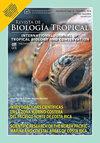Comportamiento de apareamiento del tiburón limón Negaprion brevirostris (Carcharhiniformes: Carcharhinidae), revelado por la ciencia ciudadana en el Océano Atlántico Ecuatorial
IF 0.6
4区 生物学
Q4 BIOLOGY
引用次数: 0
Abstract
Introduction: Knowledge on the copulatory behavior and mating ground requirements of large sharks, including the lemon shark, Negaprion brevirostris, is scarce, hampering conservation efforts. Objective: To describe an area in the Equatorial Atlantic used as a mating ground by N. brevirostris, as well as part of the species pre-copulatory behaviors based on citizen reports. Methods: Between 2004 and 2019, recreational divers, dive guides and rangers from the Marine Protected Area (MPA) in Fernando de Noronha Archipelago (FEN) recorded courtship behaviour, females with mating scars, pregnant females, and adult males. Results: N. brevirostris was recorded mating in shallow waters (0.5-2 m deep) during the austral summer (December to March). A specific location in the MPA, Buraco da Raquel lagoon, was the main aggregation and mating site for adult N. brevirostris in FEN. Conclusions: Citizen science records allowed the identification of shallow waters as key sites for the reproduction of this shark in FEN. Results highlight the potential of citizen science contributions to knowledge of sharks in nature and show MPAs as essential for habitat conservation of sharks with decreasing populations along the Brazilian coast, such as N. brevirostris. We present management recommendations to protect N. brevirostris there and elsewhere.赤道大西洋公民科学揭示的柠檬鲨Negaprion brevirostris的交配行为
简介:关于包括柠檬鲨在内的大型鲨鱼的交配行为和交配场地要求的知识很少,阻碍了保护工作。目的:根据公民报告,描述赤道大西洋一个被短吻猪笼草用作交配场的区域,以及该物种的部分交配前行为。方法:2004年至2019年间,费尔南多·德诺罗尼亚群岛海洋保护区(MPA)的娱乐潜水员、潜水向导和护林员记录了求偶行为、有交配疤痕的雌性、怀孕的雌性和成年雄性。结果:N。据记录,短吻鳄在南半球夏季(12月至3月)在浅水区(0.5-2米深)交配。MPA中的一个特定位置,Buraco da Raquel泻湖,是成年短吻猪笼草在FEN的主要聚集和交配地点。结论:公民科学记录允许将浅水区确定为该鲨鱼在FEN繁殖的关键地点。研究结果突出了公民科学对自然鲨鱼知识的贡献潜力,并表明海洋保护区对巴西海岸数量不断减少的鲨鱼栖息地保护至关重要,如短吻鲨。我们提出了在那里和其他地方保护短吻猪笼草的管理建议。
本文章由计算机程序翻译,如有差异,请以英文原文为准。
求助全文
约1分钟内获得全文
求助全文
来源期刊

Revista De Biologia Tropical
生物-生物学
CiteScore
1.80
自引率
0.00%
发文量
23
审稿时长
4-8 weeks
期刊介绍:
The Revista de Biología Tropical / International Journal of Tropical Biology and Conservation is a mainstream scientific journal published since 1953 and covered by Web of Science; Science Citation Index; Current Contents; Google Scholar; Scopus, SciELO and nearly 50 additional indices.
A double blind system guarantees you a fair evaluation, and our world class editorial and scientific boards provides a first decision in three working days. The journal is Full Open Access and is widely read where your article can have the highest real impact.
Since its beginning in 1953, the Revista follows these principles: objective and independent evaluation of all manuscripts; transparency in all processes; ethical use of procedures, data, specimens and subjects; fair treatment of all parties; and absolute predominance of scientific rigor over any other aspect.
 求助内容:
求助内容: 应助结果提醒方式:
应助结果提醒方式:


